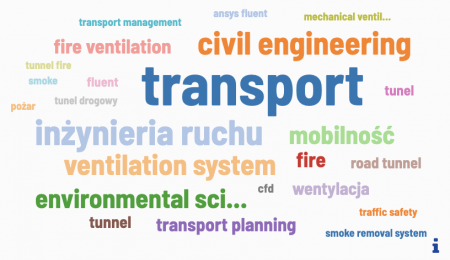In her scientific research, Prof. Król deals with issues related to fire ventilation in buildings and the influence of external parameters on the smoke extraction process. She participated in the Safe Evacuation project organized by Smay. During the project, which lasted several months, the operation of smoke extraction ventilation in an office building was studied, where tests with hot smoke and real fires were conducted. The result of the work was the development of guidelines for the design of smoke extraction ventilation systems. Her scientific interests also include the issues of road tunnel ventilation. She co-founded an informal research team, which included employees of the Faculty of Transport, the Faculty of Mining and the Faculty of Environmental and Energy Engineering. The team conducted studies of natural and forced air flows in real road tunnels, supported by the State Fire Service and the General Directorate for National Roads and Motorways. The studies included the operation of jet ventilation in the tunnel in Laliki and studies of natural draft and the operation of mechanical ventilation in the tunnel under the Martwa Wisła. Extensive measurement data collected during the research were the basis for a number of publications and were the starting point for analyses concerning the conditions of evacuation of people from tunnels during the development of a fire.
In addition to measurements, she uses CFD programs such as Fire Dynamics Simulation and Ansys Fluent in her work.
In the years 2010-2013 she participated in the Strategic Research Project Integrated system for reducing the operational energy consumption of buildings. As part of which she participated in the development of a new, fast method of in situ thermal diagnostics of buildings with particular emphasis on ventilation system elements. The final effect of the project was the publication of the guide Thermal diagnostics guide for buildings.
In the years 2000-2005, under Professor Ryszard Białecki’s supervision, she studied heat losses through windows. The research analyzed glass window inserts to reduce heat losses through convection. The shape of steel reinforcement was optimized in plastic frames, where the objective function was the heat flux flowing through the frame, determined by the boundary element method. A genetic algorithm controlled the changes in the shape of the steel reinforcement. The presented research was supported by a supervisory grant number 4T10B02323 and the final result of this research was a doctoral thesis entitled Optimization of thermal parameters of selected window types.

+48 32 237 28 67
Department of Heating, Ventilation and Dust Removal Technology
18 Konarskiego Street, room 232A
44-100 Gliwice
Poland
Selected journal articles:
Wind driven natural flow through the different types of openings on the façade – An experimental investigation
Król M., Król A., Koper P., Bielawski J., Krajewski G., Węgrzyński W.
Journal of Building Engineering 71, 2023, 106491, https://doi.org/10.1016/j.jobe.2023.106491
A study on airflows induced by vehicle movement in road tunnels by the analysis of bulk data from tunnel sensors
Król A., Król M., Węgrzyński W.
Tunnelling and Underground Space Technology, 132, 2023, 104888, https://doi.org/10.1016/j.tust.2022.104888
An Experimental and Numerical Study on Fire Spread in a Furnished RoomKról M., Król A. Buildings 12(12), 2022, 2189, https://doi.org/10.3390/buildings12122189 |
Numerical investigation on fire accident and evacuation in a urban tunnel for different traffic conditions
Król A., Król M.
Tunnelling and Underground Space Technology 109, 2021, 103751, https://doi.org/10.1016/j.tust.2020.103751
Full scale measurements of the operation of fire ventilation in a road tunnel
Król M., Król A., Koper P., Wrona P.
Tunnelling and Underground Space Technology 70, 2017, pp. 204-213. doi: https://doi.org/10.1016/j.tust.2017.07.016
Teaching:
- Special ventilation systems
- Fire ventilation
- Internal systems
- Ventilation and air conditioning
- Fire safety










